Synopsis
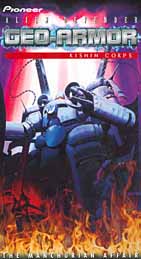
Episode 1: "Mission Call For Kishin Thunder"
Taishi Takamura listens to other passengers on a train argue about Japan's military plans in Manchuria, then turns to watch children running and playing in an idyllic countryside outside the train window. He smiles, but later an ominous silence hangs over his family's meal. That night tanks and soldiers overrun the train. Taishi's parents seem to know something, but his father only tells him that if anything should happen Taishi must escape and bring a small bag to one Mr. Saguro. Taishi nods and watches the silhouetted murder of his father as soldiers gun him down.
Two months later Taishi leads a group of Dickensian street urchins who use battle tactics reminiscent of "Our Gang" to rescue a German doctor, Maria Braun, from a pair of jackbooted thugs. Maria, we learn, cared for Taishi after the battle on the train; and he dotes on her as his surrogate mother. She, however, is deeply involved in an underground resistance movement, Kishin Corps (which uses technology stolen from an army of mysterious alien attackers) to develop battle mecha superweapons to defend the earth against the aliens. Pursued by the Kanto army (the Japanese troops occupying Manchuria) and their Nazi allies who seek to steal the weapon technology for use against other nations on earth, Maria draws Taishi into this swirling mix of high concept science fiction, historical drama, cloak and dagger intrigue and classical children's literature.
Review
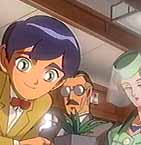
Although ostensibly set in 1941 Japan, "Geo-Armor" deftly blends familiar elements from a half a dozen screen genres and at least as many time periods into a surprisingly coherent and imaginative fictional world. Director Takaaki Ishiyama deserves accolades for the fluidity of the story as it flows through seemingly disparate ideas - a bicycle chase through the cobblestone streets of a fishing village to a pitched battle between tanks, mecha and aliens, to the drama of endearing young orphans, and finally to the megalomaniacal machinations of armies and scientists.
He balances the viewers' various expectations for each of the separate storylines in different genres so that rather than subverting or distracting, the contrasting modes of the story enhance each other. Due to the fact that the earlier scenes play up how adorable the ragamuffins are, the violence carries more meaning later when the jackbooted thugs tear apart the orphans' squat looking for Taishi and the package his father gave him. Thus, rather than seeming out of place, the somewhat cutesy elements of the story pay off by making the action and violence more affecting.
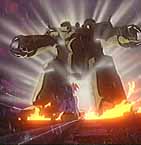
Ishiyama also manages the tricky balancing act of telling the story from multiple perspectives. Passages seen through Taishi's eyes keep the audience as unsure and overwhelmed as the young protagonist is. In other scenes Ishiyama reveals precisely enough information through snippets of overheard conversation and the reactions of background characters to convey the tensions within each opposing camp (and the many plots they lay against each other) without allowing subplots to compete with Taishi's plight for our sympathy. 'What' happens unfolds clearly, but 'why' it happens remains ambiguous - a thoroughly effective storytelling strategy.
Art director Mitsuki Nakamura and designers Masyuki Goto, Takeshi Yamazaki and Koji Watanabo find equally creative ways to integrate the visual elements of the story. Classic roadsters, rickety bicycles, dining rail cars, trench coats and women wearing stylish hats all evoke, if not the actual 1940s, then at least every movie set in the '40s.
The designs for the mecha, though, steal the show. As is de rigueur in the genre, before the battle begins the camera pans and lingers on the glinting steel framework. But in order to maintain the "believability" of battle mecha in 1941, Nakamura's camera pours over vacuum tubes, old-fashioned transistors, propeller engines, steam powered body parts and other authentic period technology. At one point a pilot in the middle of a raging battle stops to crank a hand operated winch to rotate his mecha's cannon. The designers' unabashed mix of rigorous attention to detail and whimsical fantasy evidences a tongue in cheek wit.
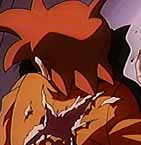
Goto's character design is less inspired, but so it goes in most mecha-driven anime. Both the good and the bad guys have a lantern-jawed muscular loudmouth, Daisaku Sukaki and Masao Goto respectively, as their chief flunky. Arch villain Colonel Shinkai has a bloated eye, a scarred face and pointed ears. And, coincidentally, he only appears in settings that are heavily bathed in a blood red glow - a sunset, a warning light, a fire, etc.
Nevertheless, "Geo-Armor's" design, art and direction effectively and ingeniously blend its many parts to create a world and story that feels both classic as well as fantastic.
Ratings
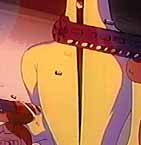
Overall: 7.5
Music, art, character and story are all strong, but so far only the design is great.
Story: 7.5
The highly charged period setting and contrasting styles concretely grounds and gives meaning to otherwise familiar elements worked into the plot.
Character Development: 7.0
A first episode needs to introduce characters and establish their relationships. The real development comes later in a series.
Art/Animation: 8.0
Each character has a specific and appropriate, though perhaps not brilliant, design. No two look alike unless they are supposed to. The backgrounds and mechanical designs are excellent but the mecha battles could be more dynamic.
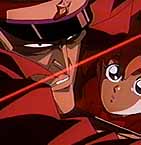
Translation: 7.0
Idioms in this translation make perfect sense. On the other hand Taishi threatens at one point to "mush" another character.
Acting: 6.0
As with the design, everyone is distinctive, which lends clarity to the more frenzied scenes.
MPAA Equivalent: PG
Chases and fights abound but without much gore.
X-Factors
Shadow puppet-fu: 6.0
The murder of Taishi's father and one of his orphan friends are both seen only as shadows killing shadows.
Deus Ex Machina: 6.0
No one knows what the heck it is, or how it works, but everyone is after the "module" because you can't run a good mecha without it. Next thing you know they'll be saying it can turn lead to gold or help you lose weight without dieting.
Information
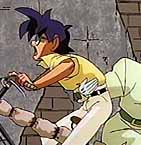
Title
Alien Defender Geo-Armor, Kishin Corps - The Manchurian Affair
Format
VHS
Language
Japanese w/ English Subtitles
Series Length
7 episodes
Time Length
60 minutes
US Production Co.
Pioneer Entertainment (USA)
US Producer
Hideki "Henry" Goto
US Director
Sarah-Anne Dafoe
Translation
Pioneer LODC
Genre
Historical Action
US Release Date
1999
Character Designer
Masayuki Goto
Mechanical Designer
Takeshi Yamazaki and Koji Watanabo
Original Concept
Masahi Yamada
Original Story
Yoshiki Tanaka, Megumi Sugihara (screenplay)
Original Studio
Pioneer LDC, Inc.
Japanese Distributor
Sony
Japanese Producer
Ginga Teikoku
Japanese Director
Takaaki Ishiyama
Music Composer
Kaoru Wada
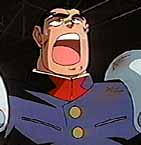
Japanese Cast
Toshio Fujita (Taishi)
Sakae Takiyama (Tatsushi Takamura)
Toshio Furukawa (Yoshimitsu Saguro)
Masashi Hionaka (Kimihiko Masumi)
Bin Shimada (Daisaku Sakaki)
Maria Kawamura (Bareiho)
Norio Wakamoto (Matao Shinkai)
Hirohiko Kakegawa (Masao Goto)
Yuriko Yamamoto (Yoshiko Fujishima)
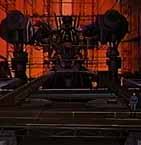
Alien Defender Geo-Armor, Kishin Corps © Masaki Yamada / Chuokoronsha / Pioneer LDC, Inc.
All images used with permission.






